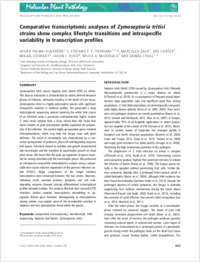Comparative transcriptomic analyses of Zymoseptoria tritici strains show complex lifestyle transitions and intraspecific variability in transcription profiles.
- Palma-Guerrero J Plant Pathology, Institute of Integrative Biology, ETH Zurich, 8092, Zurich, Switzerland.
- Torriani SF Plant Pathology, Institute of Integrative Biology, ETH Zurich, 8092, Zurich, Switzerland.
- Zala M Plant Pathology, Institute of Integrative Biology, ETH Zurich, 8092, Zurich, Switzerland.
- Carter D School of Molecular Bioscience, University of Sydney, Sydney, NSW, Australia.
- Courbot M Syngenta Crop Protection AG, Schaffhauserstrasse, 4332, Stein, Switzerland.
- Rudd JJ Department of Plant Biology and Crop Science, Rothamsted Research, Harpenden, Hertfordshire, AL5 2JQ, UK.
- McDonald BA Plant Pathology, Institute of Integrative Biology, ETH Zurich, 8092, Zurich, Switzerland.
- Croll D Plant Pathology, Institute of Integrative Biology, ETH Zurich, 8092, Zurich, Switzerland.
- 2015-11-27
Published in:
- Molecular plant pathology. - 2016
RNA sequencing
Septoria leaf blotch
Zymoseptoria tritici
comparative transcriptomics
hemibiotroph
Ascomycota
Cell Wall
Cluster Analysis
Gene Expression Profiling
Gene Expression Regulation, Fungal
Gene Ontology
Genes, Fungal
Plant Diseases
Plant Leaves
Sequence Analysis, RNA
Species Specificity
Time Factors
Transcription, Genetic
Transcriptome
Triticum
Up-Regulation
Virulence
English
Zymoseptoria tritici causes Septoria tritici blotch (STB) on wheat. The disease interaction is characterized by clearly defined temporal phases of infection, ultimately resulting in the death of host tissue. Zymoseptoria tritici is a highly polymorphic species with significant intraspecific variation in virulence profiles. We generated a deep transcriptomic sequencing dataset spanning the entire time course of an infection using a previously uncharacterized, highly virulent Z. tritici strain isolated from a Swiss wheat field. We found that seven clusters of gene transcription profiles explained the progression of the infection. The earliest highly up-regulated genes included chloroperoxidases, which may help the fungus cope with plant defences. The onset of necrotrophy was characterized by a concerted up-regulation of proteases, plant cell wall-degrading enzymes and lipases. Functions related to nutrition and growth characterized late necrotrophy and the transition to saprotrophic growth on dead plant tissue. We found that the peak up-regulation of genes essential for mating coincided with the necrotrophic phase. We performed an intraspecies comparative transcriptomics analysis using a comparable time course infection experiment of the genome reference isolate IPO323. Major components of the fungal infection transcriptome were conserved between the two strains. However, individual small, secreted proteins, proteases and cell wall-degrading enzymes showed strongly differentiated transcriptional profiles between isolates. Our analyses illustrate that successful STB infections involve complex transcriptomic remodelling to up-regulate distinct gene functions. Heterogeneity in transcriptomes among isolates may explain some of the considerable variation in virulence and host specialization found within the species.
- Language
-
- English
- Open access status
- green
- Identifiers
-
- DOI 10.1111/mpp.12333
- PMID 26610174
- Persistent URL
- https://folia.unifr.ch/global/documents/24535
Statistics
Document views: 16
File downloads:
- fulltext.pdf: 0
